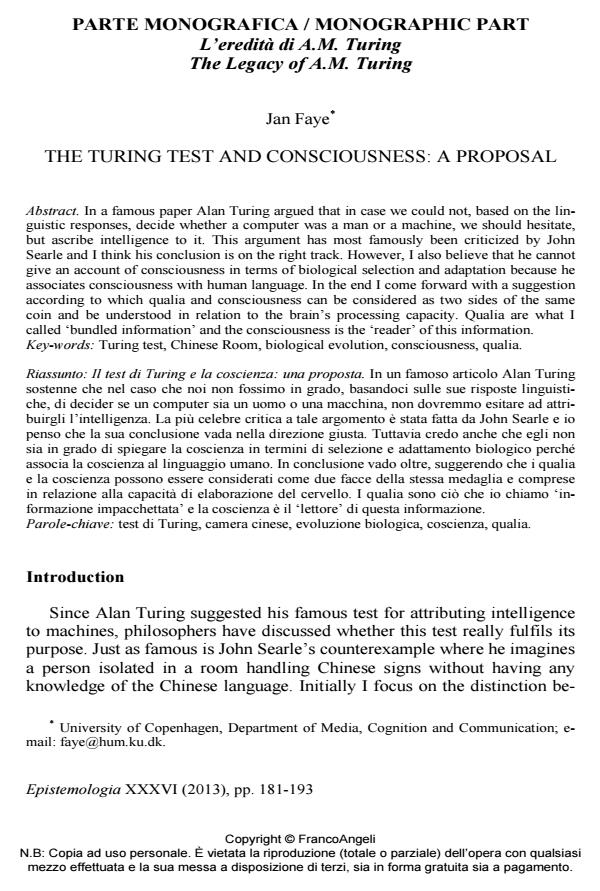The turing test and consciousness: a proposal
Titolo Rivista EPISTEMOLOGIA
Autori/Curatori Faye Jan
Anno di pubblicazione 2014 Fascicolo 2013/2
Lingua Inglese Numero pagine 13 P. 181-193 Dimensione file 595 KB
DOI 10.3280/EPIS2013-002001
Il DOI è il codice a barre della proprietà intellettuale: per saperne di più
clicca qui
Qui sotto puoi vedere in anteprima la prima pagina di questo articolo.
Se questo articolo ti interessa, lo puoi acquistare (e scaricare in formato pdf) seguendo le facili indicazioni per acquistare il download credit. Acquista Download Credits per scaricare questo Articolo in formato PDF

FrancoAngeli è membro della Publishers International Linking Association, Inc (PILA)associazione indipendente e non profit per facilitare (attraverso i servizi tecnologici implementati da CrossRef.org) l’accesso degli studiosi ai contenuti digitali nelle pubblicazioni professionali e scientifiche
In a famous paper Alan Turing argued that in case we could not, based on the linguistic responses, decide whether a computer was a man or a machine, we should hesitate, but ascribe intelligence to it. This argument has most famously been criticized by John Searle and I think his conclusion is on the right track. However, I also believe that he cannot give an account of consciousness in terms of biological selection and adaptation because he associates consciousness with human language. In the end I come forward with a suggestion according to which qualia and consciousness can be considered as two sides of the same coin and be understood in relation to the brain’s processing capacity. Qualia are what I called ‘bundled information’ and the consciousness is the ‘reader’ of this information.
In un famoso articolo Alan Turing sostenne che nel caso che noi non fossimo in grado, basandoci sulle sue risposte linguistiche, di decider se un computer sia un uomo o una macchina, non dovremmo esitare ad attribuirgli l’intelligenza. La più celebre critica a tale argomento è stata fatta da John Searle e io penso che la sua conclusione vada nella direzione giusta. Tuttavia credo anche che egli non sia in grado di spiegare la coscienza in termini di selezione e adattamento biologico perché associa la coscienza al linguaggio umano. In conclusione vado oltre, suggerendo che i qualia e la coscienza possono essere considerati come due facce della stessa medaglia e comprese in relazione alla capacità di elaborazione del cervello. I qualia sono ciò che io chiamo ‘informazione impacchettata’ e la coscienza è il ‘lettore’ di questa informazione.
Parole chiave:Test di Turing, camera cinese, evoluzione biologica, coscienza, qualia
Faye Jan, The turing test and consciousness: a proposal in "EPISTEMOLOGIA" 2/2013, pp 181-193, DOI: 10.3280/EPIS2013-002001